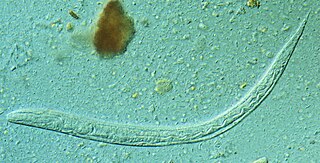
Strongyloides stercoralis is a human pathogenic parasitic roundworm causing the disease strongyloidiasis. Its common name in the US is threadworm. In the UK and Australia, however, the term threadworm can also refer to nematodes of the genus Enterobius, otherwise known as pinworms.

Helminthiasis, also known as worm infection, is any macroparasitic disease of humans and other animals in which a part of the body is infected with parasitic worms, known as helminths. There are numerous species of these parasites, which are broadly classified into tapeworms, flukes, and roundworms. They often live in the gastrointestinal tract of their hosts, but they may also burrow into other organs, where they induce physiological damage.

The Asian small-clawed otter, also known as the oriental small-clawed otter and the small-clawed otter, is an otter species native to South and Southeast Asia. It has short claws that do not extend beyond the pads of its webbed digits. With a total body length of 730 to 960 mm, it is the smallest otter species in the world.

The North American river otter, also known as the northern river otter or common otter, is a semiaquatic mammal endemic to the North American continent found in and along its waterways and coasts. An adult North American river otter can weigh between 5.0 and 14 kg. The river otter is protected and insulated by a thick, water-repellent coat of fur.

The Eurasian otter, also known as the European otter, Eurasian river otter, common otter, and Old World otter, is a semiaquatic mammal native to Eurasia. The most widely distributed member of the otter subfamily (Lutrinae) of the weasel family (Mustelidae), it is found in the waterways and coasts of Europe, many parts of Asia, and parts of northern Africa. The Eurasian otter has a diet mainly of fish, and is strongly territorial. It is endangered in some parts of its range, but is recovering in others.

Lutra is a genus of otters, one of seven in the subfamily Lutrinae.

Helminthic therapy, an experimental type of immunotherapy, is the treatment of autoimmune diseases and immune disorders by means of deliberate infestation with a helminth or with the eggs of a helminth. Helminths are parasitic worms such as hookworms, whipworms, and threadworms that have evolved to live within a host organism on which they rely for nutrients. These worms are members of two phyla: nematodes, which are primarily used in human helminthic therapy, and flat worms (trematodes).

Aonyx is a genus of otters, containing three species, the African clawless otter, the Congo clawless otter, and the Asian small-clawed otter. The word aonyx means "clawless", derived from the prefix a- ("without") and onyx ("claw/hoof").

The pinworm, also known as threadworm or seatworm, is a parasitic worm. It is a nematode (roundworm) and a common intestinal parasite or helminth, especially in humans. The medical condition associated with pinworm infestation is known as pinworm infection (enterobiasis) or less precisely as oxyuriasis in reference to the family Oxyuridae.

Profilicollis is a genus of acanthocephalan parasites of crustaceans. The status of the genus Profilicollis has been debated, and species placed in this genus were formerly included in the genus Polymorphus. However, research on the morphology of the group and their use of hosts has concluded that Profilicollis and Polymorphus should be regarded as distinct genera, and species previously described as Polymorphus altmani are now referred to as Profilicollis altmani in the literature. Profilicollis parasites infect decapod crustaceans, usually shore crabs, as intermediate hosts, and use many species of shorebirds as definitive (final) hosts.
Maritrema is a genus of trematodes (flukes) in the family Microphallidae, although some have suggested its placement in the separate family Maritrematidae. It was first described by Nikoll in 1907 from birds in Britain. Species of the genus usually infect birds, but several have switched hosts and are found in mammals, such as the marsh rice rat. Several species use the fiddler crab Uca pigilator as an intermediate host.
Strongyloides dasypodis is a parasitic roundworm infecting the large intestine of the armadillo, Dasypus novemcinctus. It was first described from Louisiana.
Strongyloides ardeae is a parasitic roundworm infecting the small intestine of yellow-crowned night heron, Nyctanassa violacea, and eastern green heron, Butorides virescens. It was first described from Louisiana.
Strongyloides physali is a parasitic roundworm infecting the large intestine of the Gulf Coast toad. It was first described from Louisiana.
Strongyloides serpentis is a parasitic roundworm infecting the intestine of the green water snake, hence its name. It was first described from Louisiana.
Strongyloides gulae is a parasitic roundworm infecting the esophagus of the green water snake, as well as eight other species of snakes. It was first described from Louisiana.
Strongyloides procyonis is a parasitic roundworm infecting the small intestine of the raccoon, Procyon lotor, hence its name. It was first described from Louisiana. It is morphologically similar to S. stercoralis, and as such infections of S. procyonis in humans, dogs, and other animals might be mistaken for the former.
Vagococcus lutrae is a Gram-positive and coccus-shaped bacterium from the genus of Vagococcus which has been isolated from a otter. Vagococcus lutrae can cause infection in humans in rare cases.









